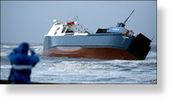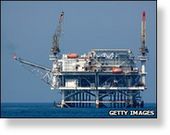
© PAIn 2008, a cargo ship was grounded off Blackpool after being hit by a freak wave
Scientists in the US have made a major advance in their understanding of so-called freak waves.
These monster waves present a major risk to ships and offshore platforms.
A computer simulation developed by oceanographers in the US could help locate where and when these "rogue" phenomena are most likely to occur.
The theoretical study shows that coastal areas with variations in water depth and strong currents are hot spots for freak waves.
The history of seafaring is littered with tales of rogue waves capable of rending ships asunder.
A freak wave is one that measures roughly three times higher than other swells on the sea at any one time. These phenomena can measure up to 18m (60ft) - the height of a six-storey building.
The new computer simulation was developed by Tim Janssen of San Francisco State University (SFSU) and Thomas HC Herbers of the Naval Postgraduate School in Monterey, California.
Their findings are published in the
Journal of Physical Oceanography.
Focal zoneSandbanks and strong currents may cause waves to change direction and speed. This concentrates wave energy into a single point, which oceanographers call a "wave focal zone".
This zone is like a burning glass, Dr Janssen explained, where the light comes in and focuses all the energy on a single point, forming a hot spot.
The same happens when a wave travels over, for example, a sandbank, or over a current. The energy is being focused on to a single point.

© Getty ImagesThe research could help inform the design of offshore platforms
The researchers found these hot spots were much more likely to drive the formation of extreme waves.
"In a normal wave field, on average, roughly three waves in every 10,000 are extreme waves," Dr Janssen explained.
"In a focal zone, this number could increase to about three in every 1,000 waves."
The scientists fed data on real waves into their computer model. Then, they repeated a single experiment over and over, each time using different data.
The SFSU oceanographer said he next hoped to go to known freak wave hotspots such as the Cortez Banks on the coast of California to test whether his simulations held true.
"What's really important about this research, is that it is easy to validate. We have a theory now, a prediction, and we can go to areas and actually measure whether this happens or not," he told BBC News.
Vital knowledgeUnderstanding where and when freak waves are most likely to occur could assist shipping and navigation in coastal areas.
The knowledge could be used for marine weather forecasts and could also inform the design of offshore platforms.
"If you know that a certain area is very prone to freak waves, then you might wish to stay away from it," Dr Janssen said.
"Anybody out in the ocean would like to [have this information]."
However, Dr Janssen was keen to stress that the study is theoretical.
"We have tried to be as realistic as we could, but we are a long way away from making a prediction solid enough for people to actually use. However, it might be something to work towards," he said.
Dr Janssen added that the word "freak wave" was unfortunate, as it suggests these types of wave are unexpected. But, he explained, the random nature of ocean waves means that any size of wave can happen at any time.


Reader Comments
to our Newsletter